
Lycopodiella is a genus in the clubmoss family Lycopodiaceae. The genus members are commonly called bog clubmosses, describing their wetland habitat. The genus has a cosmopolitan distribution, with centers of diversity in the tropical New World and New Guinea. In the past, the genus was often incorporated within the related genus Lycopodium, but was segregated in 1964. In the Pteridophyte Phylogeny Group classification of 2016, Lycopodiella is placed in the subfamily Lycopodielloideae, along with three other genera. In this circumscription, the genus has about 15 species. Other sources use a wider circumscription, in which the genus is equivalent to the Lycopodielloideae of PPG I, in which case about 40 species and hybrids are accepted.

Flora of Australia is a 59 volume series describing the vascular plants, bryophytes and lichens present in Australia and its external territories. The series is published by the Australian Biological Resources Study who estimate that the series when complete will describe over 20 000 plant species. It was orchestrated by Alison McCusker.
Prodromus Florae Novae Hollandiae et Insulae Van Diemen is book dealing with the flora of Australia written by botanist Robert Brown and published in 1810. Often referred to as Prodromus Flora Novae Hollandiae, or by its standard botanical abbreviation Prodr. Fl. Nov. Holland., it was the first attempt at a survey of the Australian flora. It described over 2040 species, over half of which were published for the first time.

Santalum lanceolatum is an Australian tree of the family Santalaceae. It is commonly known as desert quandong, northern sandalwood, sandalwood, or true sandalwood and in some areas as burdardu. The mature height of this plant is variable, from 1 to 7 m. The flowers are green, white, and cream, appearing between January and October. The species has a distribution throughout central Australia, becoming scattered or unusual in more southern regions.

Spinifex longifolius, commonly known as beach spinifex, is a perennial grass that grows in sandy regions along the seacoast. It also lives in most deserts around Australia.
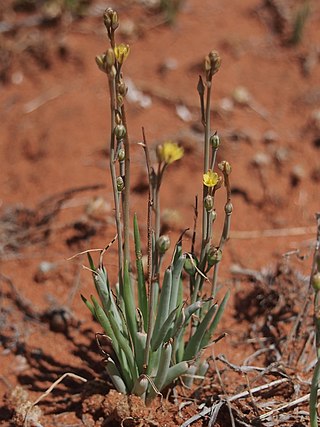
Bulbine semibarbata, commonly known as leek lily, native leek or wild onion, is a species of annual herb native to Australia.
Pentapogon is a genus of Australian plants in the grass family. The only known species is Pentapogon quadrifidus. It is native to every Australian State except Queensland, and is also naturalised on the South Island of New Zealand.
Leptaspis is a genus of Paleotropical plants in the grass family, native to Africa, southern Asia, northern Australia, and a few islands of the western Pacific.

Chloanthes is a genus of four species of flowering plants in the family Lamiaceae and is endemic to Australia. Plants in this genus are shrubs with hairy foliage, blistered or wrinkly leaves and flowers with five petals fused at the base, usually with two "lips".

Johnsonia is a genus composed of five species of herbs in the family Asphodelaceae, all of which are endemic to the south-west of Western Australia. They are grass-like plants with minute flowers surrounded by bracts which are often tinged with white, pink or cream.

Schizaea rupestris is a small Australian fern. Most populations are in found in the ranges near Sydney. However, it also occurs near Woolgoolga and Western Australia.
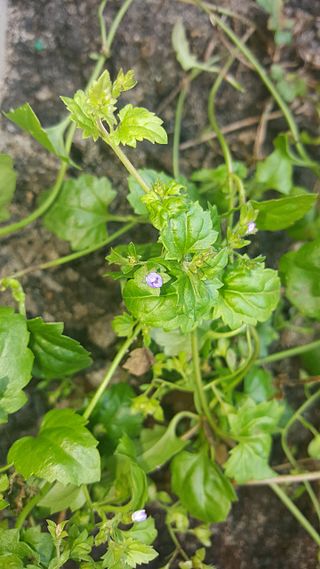
Veronica plebeia, commonly known as creeping- or trailing speedwell, is a species of flowering plant belonging to the family Plantaginaceae. It is native to Australia and New Zealand.
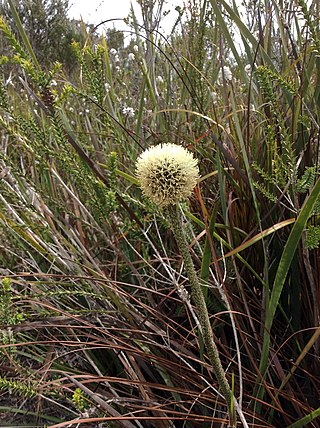
Dasypogon bromeliifolius, commonly known as pineapple bush, is a species of shrub in the family Dasypogonaceae native to Western Australia.
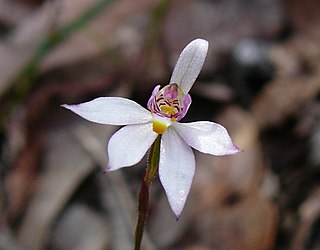
Caladenia alata, commonly known as the fairy orchid, is a plant in the orchid family Orchidaceae and is found in south-eastern Australia and New Zealand. It is a ground orchid with small, usually short-lived flowers, which have relatively stiffly held petals and sepals and reddish-purple bars on the labellum.
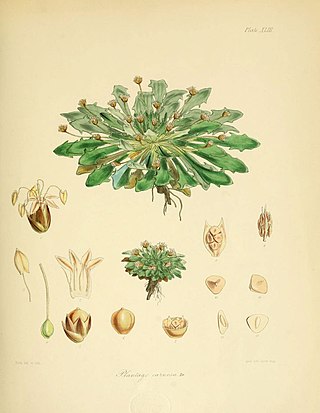
Plantago triantha is an annual plant of the family Plantaginaceae that is found in both Tasmania and the Auckland Islands.

Alternanthera denticulata is a small prostrate white-flowering herb in the Amaranthaceae family. It is native to all states and territories of Australia, New Guinea, and the North Island of New Zealand. It is also one of the food plants of the varied eggfly, Hypolimnas bolina nerina.

Samolus junceus in the family Primulaceae is a species of water pimpernel native to Western Australia.

Myosotis australis is a species of flowering plant in the family Boraginaceae, native to New Zealand, Australia and New Guinea. Robert Brown described this species in 1810. Plants of this species of forget-me-not are perennial rosettes with ebracteate inflorescences and white or yellow corollas with stamens that are fully included in the corolla tube or sometimes partly protruded.

Myosotis australissubsp. australis is a subspecies of flowering plant in the family Boraginaceae, native to New Zealand and Australia. Robert Brown described M. australis in 1810. Plants of this subspecies of forget-me-not are perennial rosettes with ebracteate inflorescences and white or yellow corollas with stamens that are fully included in the corolla tube or sometimes partly protruded.

Myosotis suavis is a species of flowering plant in the family Boraginaceae, endemic to the South Island of New Zealand. Donald Petrie described the species in 1914. Plants of this species of forget-me-not are perennial rosettes with ebracteate inflorescences and white corollas with stamens that are partially exserted.


















